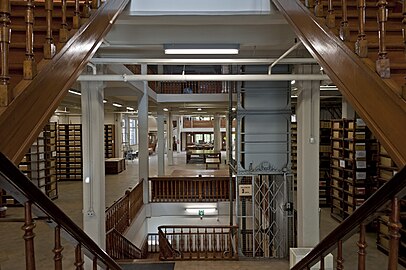
Brussels, officially the Brussels-Capital Region, is a region of Belgium comprising 19 municipalities, including the City of Brussels, which is the capital of Belgium. The Brussels-Capital Region is located in the central portion of the country and is a part of both the French Community of Belgium and the Flemish Community, but is separate from the Flemish Region and the Walloon Region, located less than 4 kilometres (2.5 mi) to the south. Historically Dutch-speaking, Brussels saw a language shift to French from the late 19th century. Nowadays, the Brussels-Capital Region is officially bilingual in French and Dutch, although French is the majority language and lingua franca. Brussels is also increasingly becoming multilingual. English is spoken widely and many migrants and expatriates speak other languages as well.

Manneken Pis is a landmark 55.5 cm (21.9 in) bronze fountain sculpture in central Brussels, Belgium, depicting a puer mingens; a naked little boy urinating into the fountain's basin. Though its existence is attested as early as the mid-15th century, Manneken Pis was redesigned by the Brabantine sculptor Jérôme Duquesnoy the Elder and put in place in 1619. Its stone niche in rocaille style dates from 1770. The statue has been repeatedly stolen or damaged throughout its history. Since 1965, a replica has been displayed, with the original stored in the Brussels City Museum.
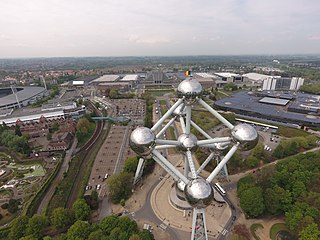
The Heysel Plateau or Heysel Park, usually shortened to Heysel or Heizel, is a neighbourhood, park and exhibition space in Laeken, northern Brussels, Belgium, where the Brussels International Exposition of 1935 and the 1958 Brussels World's Fair took place.

Molenbeek-Saint-Jean or Sint-Jans-Molenbeek, often simply called Molenbeek, is one of the 19 municipalities of the Brussels-Capital Region, Belgium. Located in the western part of the region, it is bordered by the City of Brussels, from which it is separated by the Brussels–Charleroi Canal, as well as by the municipalities of Anderlecht, Berchem-Sainte-Agathe, Dilbeek, Jette, and Koekelberg. The Molenbeek brook, from which it takes its name, flows through the municipality. In common with all of Brussels' municipalities, it is legally bilingual (French–Dutch).

The Royal Theatre of La Monnaie is an opera house in central Brussels, Belgium. The National Opera of Belgium, a federal institution, takes the name of this theatre in which it is housed—La Monnaie in French or De Munt in Dutch—referring both to the building as well as the opera company. As Belgium's leading opera house, it is one of the few cultural institutions to receive financial support from the Federal Government of Belgium. Other opera houses in Belgium, such as the Vlaamse Opera and the Opéra Royal de Wallonie, are funded by regional governments.

The City of Brussels is the largest municipality and historical centre of the Brussels-Capital Region, as well as the capital of the Flemish Region and Belgium. The City of Brussels is also the administrative centre of the European Union, as it hosts a number of principal EU institutions in its European Quarter.
The Parc du Cinquantenaire or Jubelpark is a large public, urban park of 30 ha in the easternmost part of the European Quarter in Brussels, Belgium.
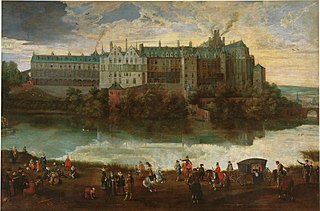
The Palace of Coudenberg was a royal residence situated on the Coudenberg or Koudenberg, a small hill in what is today the Royal Quarter of Brussels, Belgium.

The Mont des Arts or Kunstberg, meaning "Hill/Mount of the Arts", is an urban complex and historic site in central Brussels, Belgium, including the Royal Library of Belgium (KBR), the National Archives of Belgium, the Square – Brussels Meeting Centre, and a public garden.

The Royal Academy of Fine Arts of Brussels is an art school established in Brussels, Belgium. It was founded in 1711. Starting from modest beginnings in a single room in Brussels' Town Hall, it has since 1876 been operating from a former convent and orphanage in the Rue du Midi/Zuidstraat, which was converted by the architect Victor Jamaer. The school has played an important role in training leading local artists.

The Fortifications of Brussels refers to the medieval city walls that surrounded Brussels, Belgium, built primarily to defend the city but also for administrative reasons. There were two stages of fortifications of Brussels: the first walls, built in the early 13th century, and the second walls, built in the late 14th century and later upgraded. In the 19th century, the second walls were torn down and replaced with the Small Ring, a series of boulevards bounding the historical city centre. Nowadays, only a few sections of each walls remain, most notably the Halle Gate.

The Halle Gate is a former medieval city gate and the last vestige of the second walls of Brussels, Belgium. Built between 1381 and 1383, it was heavily restored in the 19th century in its current neo-Gothic style by the architect Henri Beyaert. It is now a museum dedicated to the medieval City of Brussels, part of the Royal Museums of Art and History (RMAH).

The Place Royale or Koningsplein is a historic neoclassical square in the Royal Quarter of Brussels, Belgium. Modelled after the so-called French royal square and built between 1775 and 1782, according to a plan of the architects Jean-Benoît-Vincent Barré and Gilles-Barnabé Guimard, to replace the former Palace of Coudenberg, it was part of an urban project including Brussels Park.
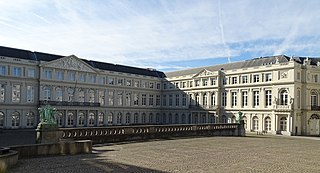
The Palace of Charles of Lorraine is a neoclassical palace in the Royal Quarter of Brussels, Belgium. Its construction started in 1757 to serve as the residence of the Governor of the Habsburg Netherlands, Prince Charles Alexander of Lorraine, replacing the Palace of Orange-Nassau. It currently houses a museum, part of the Royal Library of Belgium (KBR).

The Temple of the Augustinians, alternatively the Church of the Augustinians in Brussels, Belgium, was a Brabantine Baroque-style church designed and built from 1621 to 1642 by the architect Jacob Franquart for the Augustinians order. It was located on the Place de Brouckère/De Brouckèreplein in central Brussels until its demolition in 1893–94. Its facade's masonry, however, was preserved, being disassembled and reconstructed as the facade of the Church of the Holy Trinity in Ixelles.

The following is a timeline of the history of Brussels, Belgium.
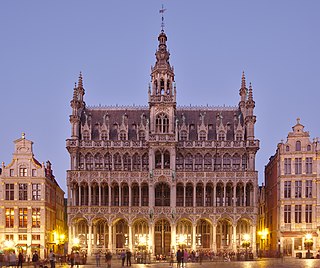
The Brussels City Museum is a municipal museum on the Grand-Place/Grote Markt of Brussels, Belgium. Conceived in 1860 and inaugurated in 1887, it is dedicated to the history and folklore of the City of Brussels from its foundation into modern times, which it presents through paintings, sculptures, tapestries, engravings, photos and models, including a notable scale-representation of the town during the Middle Ages.
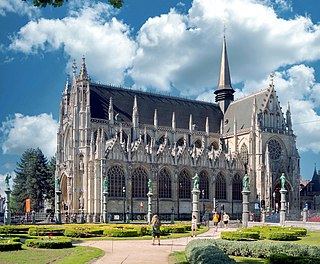
The Sablon or Zavel is a neighbourhood and hill in the historic upper town of Brussels, Belgium. At its heart are twin squares: the larger Grand Sablon or Grote Zavel square in the north-west and the smaller Petit Sablon or Kleine Zavel square and garden in the south-east, divided by the Church of Our Blessed Lady of the Sablon. This area is served by Brussels-Chapel railway station and Brussels-Central railway station, as well as the tram stop Petit Sablon/Kleine Zavel.

The Church of St. John the Baptist is a Roman Catholic parish church located in the centre of Molenbeek-Saint-Jean, a municipality of Brussels, Belgium. It is dedicated to Saint John the Baptist, the patron saint of Molenbeek.
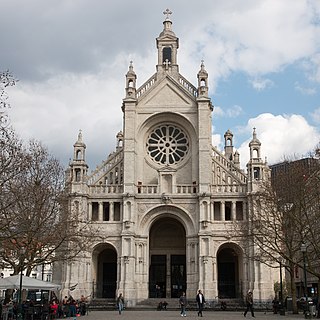
Saint Catherine's Church is a Roman Catholic parish church in Brussels, Belgium. It is dedicated to Saint Catherine.



